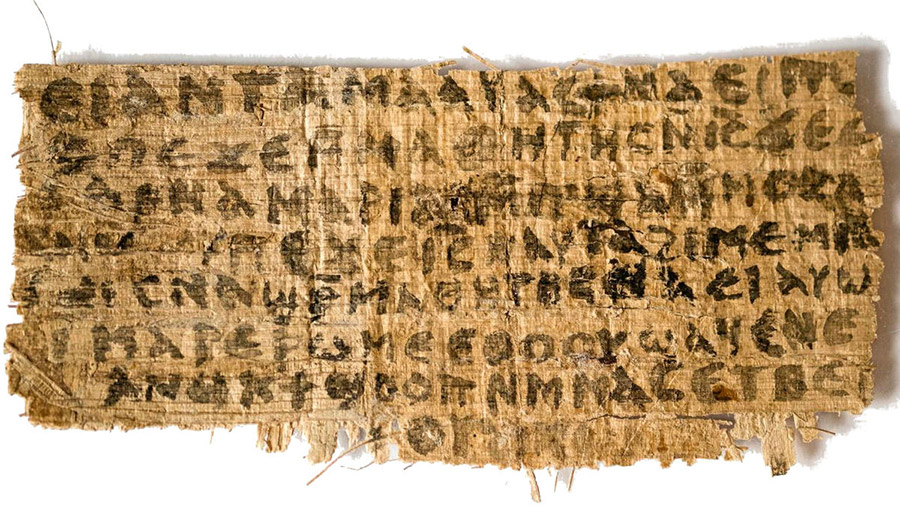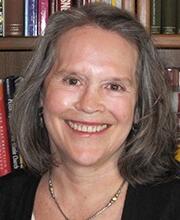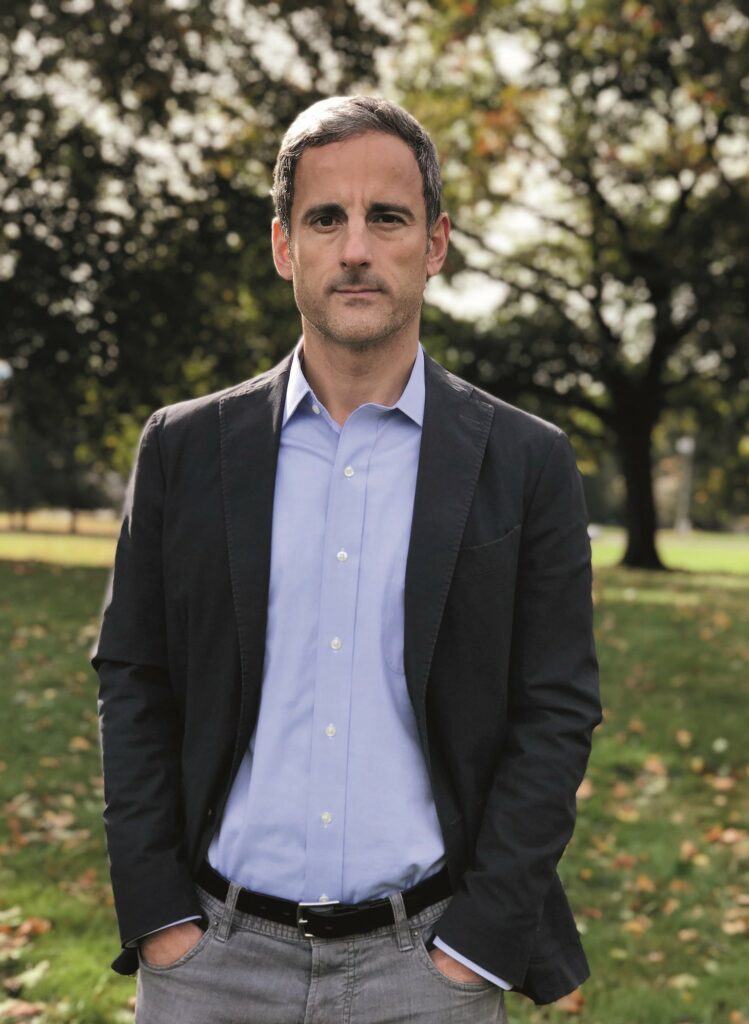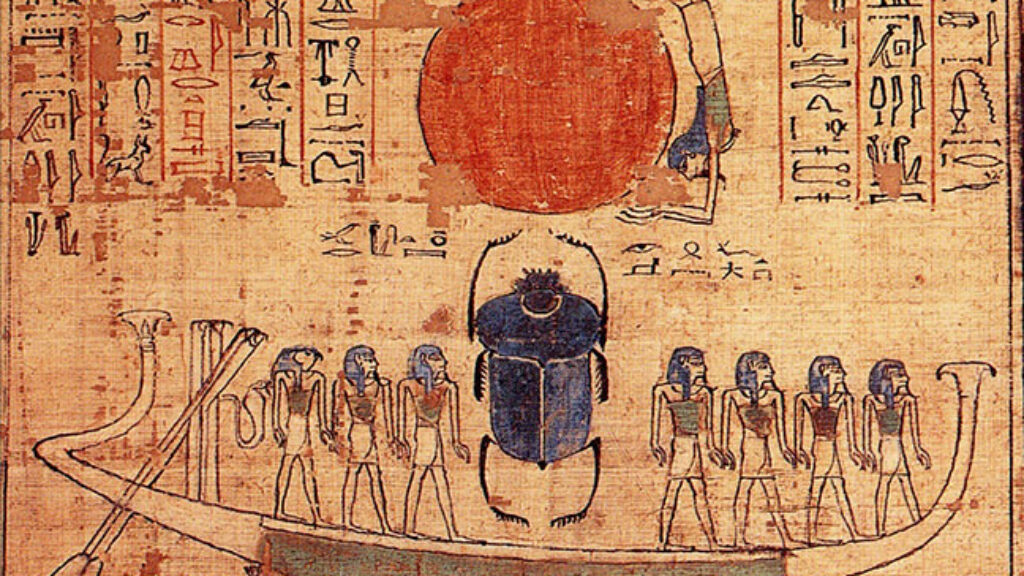The Professor and the Con Man
The saga of the papyrus that became famous as the Gospel of Jesus’s Wife began with an email sent to Karen King, a distinguished Harvard professor, in July 2010. The subject line read, simply, “Coptic gnostic gospels in my collection.”
The “gospel” in question is a fragment of papyrus about the size of a credit card. It contains eight incomplete lines of Coptic script that seem to recount Jesus arguing with disciples about the role of Mary, including an incredible reference to my wife. The fragment was rolled out to great fanfare in 2012, starring in a TV documentary and on the front page of the New York Times. Exactly a decade after that first email, after dizzying waves of media hype and astonishing twists through some of the darker alleys of biblical studies and the most fetid corners of the Internet, the saga has now brought us Veritas, a masterful unraveling of the story by the journalist Ariel Sabar.

King, who made herself the patron of the papyrus, touted it as a revolutionary glimpse into early Christianity and an artifact with immense significance for how Christians should think about family, marriage, and sexuality today. This ancient text’s message was the right one for our times: it offered, the Harvard scholar declared, “robust affirmation that women who are wives and mothers are worthy and able to be disciples of Jesus.”

At the time, King was known for her work on the early Christian dissidents known as the Gnostics. She held an august position at Harvard as Hollis Professor of Divinity, the oldest endowed professorship in America. The papyrus, to which King attached the flamboyant name “the Gospel of Jesus’s Wife,” bore her beyond the world of academic religious studies to mainstream celebrity. She staked her reputation on its authenticity. The spectacular failure of that bet is the subject of Sabar’s gripping investigation.
Sabar was among the very first reporters to cover the story, for Smithsonian magazine, and was present for all the exciting moments in the fragment’s early celebrity career. His curiosity stimulated, and his suspicions, Sabar then became the reporter who cracked the mystery in a 2016 article for the Atlantic before diving in even deeper to write this book, conducting 450 interviews and following the trail from Montana through towns in rural Germany. We follow him as he tracks leads that many reporters would have deemed too obscure to bother with, but which end up illuminating his cast of memorable characters: from King herself to the academic outsiders on basement laptops who didn’t believe her, and to the improbable Walter Fritz, a onetime Egyptology student in Berlin turned director of a Stasi museum turned internet pornographer in the Sunshine State. It was Fritz who sent the email that began the affair. “For five years,” Sabar writes in Veritas, “a scholar and a con man walked shoulder to shoulder, one in darkness, the other in light, evangelists for a lie.”

Journalistic investigations into ancient artifacts and manuscripts hold a threefold challenge. The first is summoning the stubbornness and patience necessary to track down leads and win the confidence of sources, a process that can take years with no guarantee of a payoff. The second is to access the deeper meaning of the artifact in question and its path through the world, beyond the superficial details. The third is to combine all of this into an absorbing narrative. It’s rare to succeed on all three counts, but Sabar has: Veritas is a masterpiece of the genre. It also has a larger point to make, one hinted at in the title, which is the Latin word for “truth” and the famous motto of Harvard University.
It was only the day after King’s dramatic presentation of the fragment at a conference held across the street from the Vatican (which was not amused) that Leo Depuydt, an Egyptologist at Brown University, wrote to colleagues that “the danger of making a fool of oneself is real.” The danger was indeed real, but it was ignored. The details of how things proceeded are remarkable, even to those who are skeptical about this part of the academic world—a skepticism that, in my case, came after a few years reporting on archaeology in Israel and after an investigation into the 10th-century Aleppo Codex and its dissembling scholarly custodians.
No radiocarbon dating was performed before the fragment was made public. No one had any idea where it came from or bothered to check. A few scientific tests that failed to detect the forgery were actually performed, Sabar discovered, by old friends of King. The journalist was going over a 1977 newspaper announcement of the professor’s first wedding when he noticed that the name of an usher matched the name of one of the authenticating scientists. The two turned out to have been neighbors growing up.
Despite the artifact’s clumsy Coptic handwriting and grammar, the world’s most prominent papyrologist, Robert Bagnall of NYU, judged it to be authentic. In fact, the clumsiness only made it seem less likely to be a forgery, as Bagnall explained to Sabar: “I kept saying, ‘How could somebody be so sophisticated and so unsophisticated at the same time?’” There are many more details of this kind, and of a more amazing and salacious kind, all of which would have remained in the shadows had Sabar not gone knocking on doors near Venice, Florida, trawling through obscure Coptology blogs (that’s the only kind of Coptology blog), and tracking down the scholars who picked the forgery to pieces using resources they found online.
Unavoidable throughout the story of the papyrus, and throughout Veritas, is the long, silly shadow of The Da Vinci Code, the bestseller by Dan Brown that posited a marriage between Jesus and Mary Magdalene and a lurid Catholic conspiracy to cover it up. The book’s main character, Robert Langdon, is a Harvard professor who guides readers through the sexual secrets of the early church. In the movie, the Harvard professor was played by Tom Hanks. In the true story of the “Gospel of Jesus’s Wife,” the character was played by Karen King. (This version was directed, one might say, by Walter Fritz, who of course had read the book).
In the frenzy that followed the novel’s publication in 2003, King had become one of the academics interviewed frequently on the subject, seeing the popularity of Brown’s work as an opportunity to talk about the multiplicity of voices in early Christianity and about the greater role that women played before they were sidelined by men. King was a member of a group of liberal Christian scholars known as the Jesus Seminar, who were working on a “New New Testament” and hoping to remake the religion in a way that would allow more modern interpretations to flourish. Or, as the Jesus Seminar’s founder put it: “We require a new, liberating fiction, one that squares with the best knowledge we can now accumulate and one that transcends self-serving ideologies.”
King saw herself as a historian and spoke much about “data,” but she also wrote, “History is not about truth but about power relations,” and thought the historian’s priority should be to drop “the association between truth and chronology.” All of this made King the perfect mark for the forger peddling the Gospel of Jesus’s Wife.
The chapter in which Sabar sketches the intellectual scaffolding of King’s thinking is, to my mind, the most important in the book, because it has lessons beyond a story about one fake artifact. King was taken in, in this telling, partly because she wanted to be—because, like many scholars, journalists, and even scientists, she didn’t seem to believe that truth was a matter of ascertaining facts. “In other words,” Sabar writes, “a thing was true not if it was real; it was true if—in King’s estimation—it was a moral good.” That’s the kind of thinking that has infiltrated the worlds of the media and the academy in the 21st century. King wanted the respect due to a scientist, and she wanted the freedom of the preacher. She was open to seeing the fragment as true even if it wasn’t quite real. That’s why she was the ideal address for that fateful email in July 2010. The forger’s aim, Sabar writes, was “ruthlessly precise.”
One of the book’s unlikely heroes is Christian Askeland, a New Testament Coptologist with a Cambridge PhD and a sharp eye for forgery. Askeland is an evangelical Christian, making him an outsider in the world of the mainstream academy. With the outsider’s sharpened senses and a familiarity with religious modes of thinking, Askeland understands that there are “fundamentalists” on both the left and the right. The world of religious studies at places like Harvard might have more diversity of gender and race than they used to, but “intellectually, Askeland felt, they were monoliths, often blind to their own liberal pieties.” This is an important part of the intellectual landscape of our times, and it turns out to be a key part of the sorry, fascinating, and relentlessly entertaining tale told in Veritas.
Trying to protect the papyrus that he’s successfully passed off to Harvard, the enigmatic Water Fritz denigrated Askeland and another skeptic without a prestigious academic position, describing them to Sabar as “county-level manuscript experts” from the “University of Eastern Pee-Pee Land.” But in this case, it was the crack team from UEPPL that was right, and Harvard comes off less as a dupe than as another kind of hoax. The subtitle of Veritas is A Harvard Professor, a Con Man and the Gospel of Jesus’s Wife. But there were actually two different cons operating here, and it’s their unholy union—not that of Jesus and Mary Magdalene—that is at the heart of this story.
Suggested Reading
Businesswomen Before Bar Kokhba
Why did a Jewish woman living 30 years (around 135 C.E.) after a set of real estate contracts were executed and with no obvious connection to the named parties have them in her satchel when she fled Ein Gedi?

Homer of Lod: The Indispensability of Erez Bitton
The blind writer from Algeria is one of Israel’s most important voices, both in poetry and in policy.

Exodus and Egyptology
The Koren Tanakh of the Land of Israel shows why the plagues were chosen and how the Israelites sang at the reed sea.
The Bible Scholar Who Didn’t Know Hebrew
The surprising story of Elias Bickerman and his scholarship.
Comments
You must log in to comment Log In